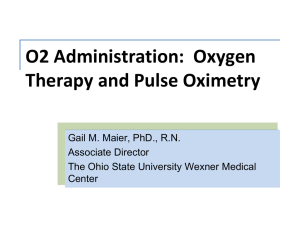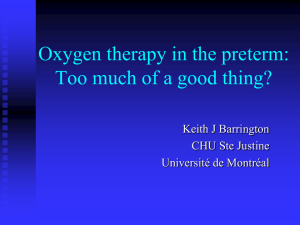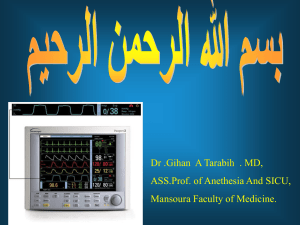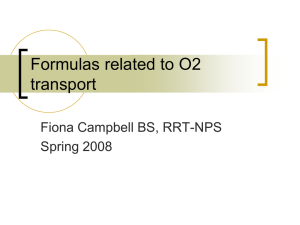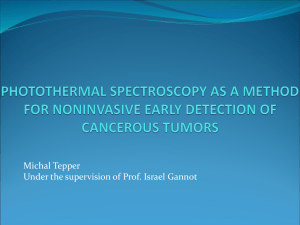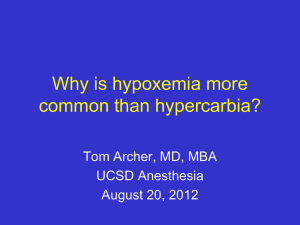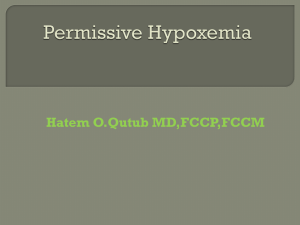PULSEOXIMETRY
advertisement
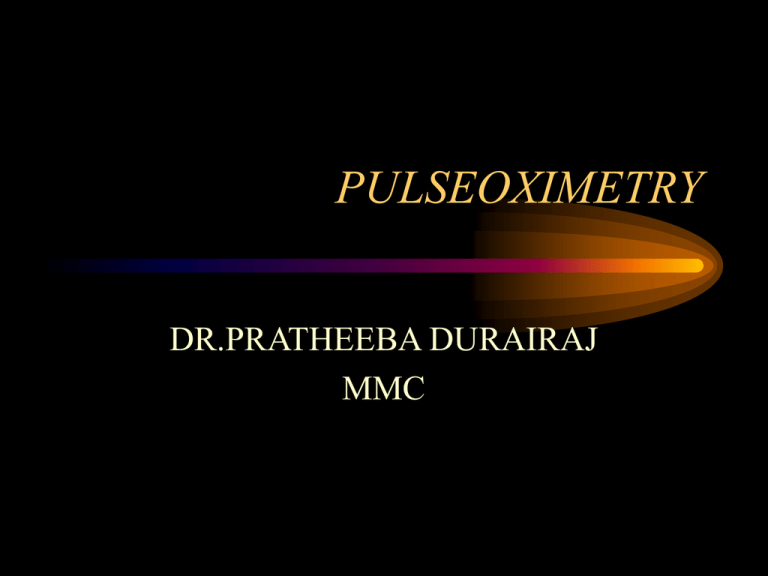
PULSEOXIMETRY DR.PRATHEEBA DURAIRAJ MMC Introduction • The maintenance of optimal O2 delivery is the core concern during anaesthesia • “Oxygen lack not only stops the machine but wrecks the machinery ”– J.S. Haldane. • Monitoring of oxygenation using pulseoximeter avoids many catastrophies DEFINITION • A NON INVASIVE TECHNOLGY TO MONITOR OXYGEN SATURATION OF THE HAEMOGLOBIN HISTORY • MATHEES- father of oximetry • 20 papers in1934 –1944 • HERTZMAN 1937 –use of photoelectric finger plethsmography • 1975 –concept of pulse oximetry –Japan • YELDERMAN &NEW -1983 –Nellcor pulse oximeter PRINCIPLES • ABSORBTION SPECTRO PHOTOMETRY • BEER LAMBERT LAW • LAMBERT’S LAW states that when a light falls on a homogenous substance,intensity of transmitted light decreases as the distance through the substance increase • BEER’S LAW states that when a light is transmitted through a clear substance with a dissolved solute ,the intensity of transmitted light decreases as the concentration of the solute increases CONTD.. • Substances have a specific pattern of absorbing specific wavelength –Extinction coefficient Uses two lights of wavelengths • 660nm –deoxy Hb absorbs ten times as oxy hb • 940 nm – absorption of oxyHb is greater • Lab oximeters use 4 wavelengths to measure 4 species of haemoglobin • It =I o e –Ecd [Ecd –absorbance] Extinction MetHb coefficient Oxy Hb Deoxy Hb COHB 660nm wavelength 940nm DESIGN OF PULSEOXIMETER • 2 WAVELENGTHS660nm [red] & 940nm[infra red] The ratio of absorbencies at these two wavelengths is calibrated empirically against direct measurements of arterial blood oxygen saturation (SaO2) in volunteers, and the resulting calibration algorithm is stored in a digital microprocessor within the pulse oximeter. • LED & PHOTODETECTOR • Newer types of LED is based on aluminium gallium arsenide system • Signal processed in the micro processor • Senses only the pulsatile flow Oxygen desaturation • Saturation is defined as ratio of O2 content to oxygen capacity of Hb expressed as a percentage. • Desaturation leads to Hypoxemia – a relative deficiency of O2 in arterial blood. PaO2 < 80mmHg – hypoxemia CONTD… • Oxygen saturation will not decrease until PaO2 is below 85mmHg. • At SaO2 of 90% PaO2 is already 60mmHg. • Rough guide for PaO2 between saturation of 90%-75% is PaO2 = SaO2 - 30. • SaO2< than 76% is life threatening. Fractional Saturation • This is Ratio of oxygenated Haemoglobin to sum of all haemoglobin in blood. Fractional saturation = HbO2 -------------------------HbO2+ Hb+ Met Hb +CO Hb Functional Saturation • This is a measure of ratio between HbO2 and sum of oxygenated and reduced Hb. • Functional Saturation= HbO2 -----------HbO2 + Hb Types of Hypoxemia 1.Hypoxic hypoxemia PaO2 SaO2 – Normal Hb 2.Anaemic hypoxemia Hb , Normal PaO2 & SaO2 3.Toxic hypoxemia SaO2,Normal PaO2 • PaO2 [mmHg] • Normal • • • • Hypoxia Mild Moderate Severe SaO2 [%] 97 to ≥80 97 to ≥95 < 80 60-79 40 – 59 <40 < 95 90-94 75 – 89 < 75 Relationship between PaO2 and SaO2 • Fig .No. 2 Oxygen – haemoglobin dissociation curve PO2 Hb% saturation 100 20 80mmHg 97.5 1.5 96% 60 20 40mmHg 91 17 74% Cardiovascular response to hypoxemia SPO2% HR BP Stroke SVR volume Response >80 No change Reflex 60-80 No change Direct <60 Direct Uses of pulseoximetry • Monitoring oxygenation During anaesthesia in ICU, PACU during transport • Monitoring oxygen therapy • Assesment of perfusion • Monitoring vascular volume • Sleep studies -24-h ambulatory recordings of SpO2 is useful for screening for daytime sleep sequelae associated with the potential risk of this pathology in OSAS during social activities. Advantages • Simple to use • Non-invasive • Require no warm up time • Especially in African &Asian patients • Cost-effectiveness over ABG Disadvantages Decrease in PAO2 before fall in SPO2 Due to the shape of ODC SPO2 94% - PAO2 75% Limitations Shivering patient -motion artefacts High intensity ambient light Perfusion of the patient ear probe may be more reliable Abnormal pulses –erratic perfomance Penumbra effect - light shunted directly to photo dectector Contd… Carboxy Hb – Produces SpO2 > than true O2 saturation 10-20% in heavy smokers At 660nm its absorbtion similar to oxyhaemoglobin ,so over reads For every 1%COHB 1% increase in pulseoximeter reading Methaemoglobinemia – absorbs equal amount of red &infra red light - Cause SpO2 to move towards 85% CONTD…. Endo / exogenous dyes interfere -Indocyanine green, indigocarmine ,methylene blue Blue ,Black ,Green nail polishes Diathermy leads to disturbance in monitor - can be corrected by placing grounding plate near surgical field probe as far away from surgical field & electro cautery Problems • False positives and negatives • Burn injury • Pressure injuries Other types of oximetry • Reflectance oximetry sense back scattered light LED placed to the side of photo diode Dis adv - noise interference & more costly Adv - signal in low perfusion is better Contd… Masimo signal extraction technology Mixed venous blood o2 saturation - by special PAC Noninvasive brain oximetry - senses regional o2 saturation in brain[rSO2] - sensor in forehead emits light of specific wavelength & measure the reflected light Transcutaneous oximetry Case Study • Consider Mrs. W., a patient scheduled to undergo an endoscopy. A complete blood count (CBC) shows her total hemoglobin level is normal – 15 mg/dl. A pulse oximeter shows that her oxygen saturation level is 97%. • To determine her overall oxygen-carrying capacity, multiply 1.34 ml (the amount of oxygen each gram of hemoglobin carries) by the hemoglobin level and then by the SpO2. 1.34 x 15 x 0.97. • The total amount of oxygen carried in Mrs. W.’s hemoglobin is 19.50 ml/dl (hemoglobin oxygen content), which falls within the normal range of 19-20 ml/dl. Contd… • Mr. B., who’s had shortness of breath for two days. His lungs are clear, and although he has not specific pulmonary symptoms, he looks malnourished and is anaemic. • A spot check with a pulse oximeter shows a SpO2 of 97%, the same as Mrs. W., you discover that Mr. B.’s hemoglobin oxygen content is 14.30 ml/dl, far below normal values. • Because Mr. B. has fewer hemoglobin molecules, the total amount of oxygen available to his tissues is low, resulting in shortness of breath. What hemoglobin he does have is full of oxygen, producing normal and misleading SpO2. • These two cases illustrate a major cautionary note: Never let normal SpO2 readings lull you into a false sense of security! Always interpret SpO2 values in the context of the patient’s total hemoglobin level. Take home message • Remember at SaO2 of 90%, PaO2 is already 60mmHg • SaO2 < than 76% is life threatening

